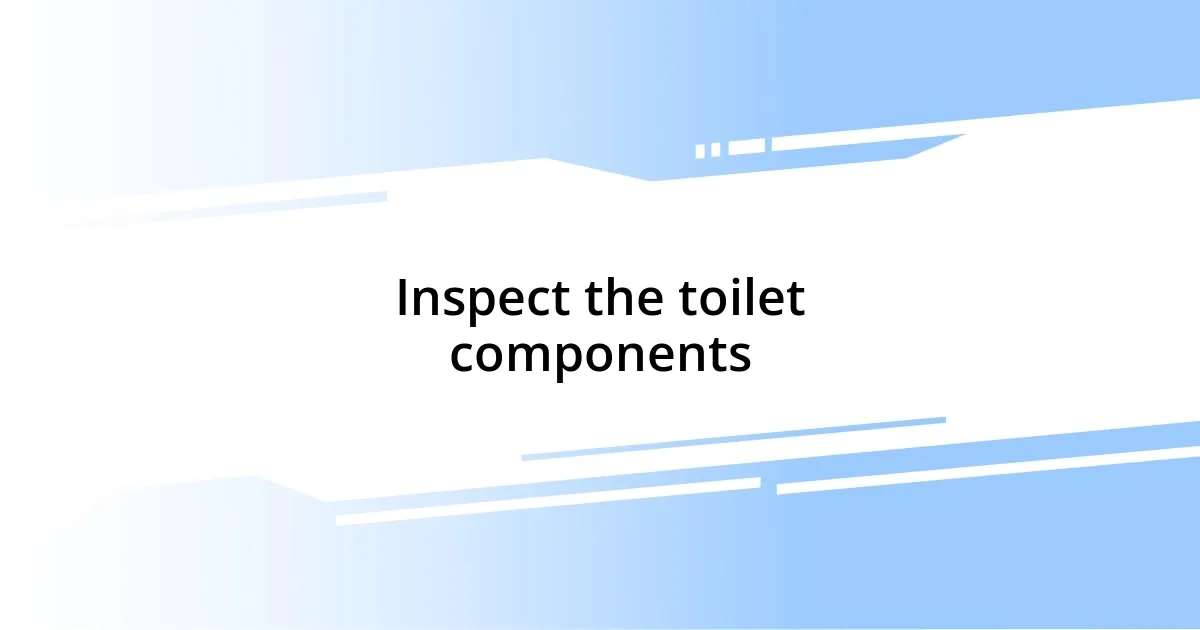Key takeaways:
- Identify sources of toilet leaks through careful inspection of components like the tank, flush valve, and wax seal.
- Regularly check and maintain essential parts, such as the flapper and chain, to prevent leaks and ensure proper flushing.
- Inspect the water supply line and tank bolts for rust or wear, as these can lead to significant leaks if neglected.
- Perform routine maintenance, including checking for mineral buildup and proper water levels, to avoid future plumbing issues.

Identify the source of leaks
Identifying the source of toilet leaks is often more than just a technical task; it’s a bit like detective work. One time, I noticed a small puddle forming near the base of my toilet, seemingly innocent at first. It didn’t take long for me to realize that it wasn’t just any water—it was my own effort to avoid the cold tile floor that had summoned this mystery!
I remember getting down on my hands and knees, flashlight in hand, inspecting every nook and cranny. Was it the wax ring under the toilet, the tank bolts, or perhaps a crack in the bowl itself? The closer I looked, the more I felt the urgency; a drip here and a trickle there can lead not just to a mess but to bigger water bills and potential damage. Asking myself, “What could this leak be costing me?” really put things into perspective.
Don’t forget about the tank, either. Sometimes, leaks can be masquerading as simple condensation, but if you’re attentive, a sneaky leak at the flush valve can be identified with a quick listen or feel. Each second counts, and being proactive in identifying the source saves time and stress later on—something I wish I had realized sooner during my “leaky toilet saga.”

Inspect the toilet components
When you’re knee-deep in a toilet leak situation, inspecting the toilet components is a crucial step. I distinctly remember the time I had to check the inner workings of my toilet for the first time. As I lifted the tank lid, I felt like I was entering a whole new world. I found parts that looked confusing yet held the key to my watery dilemma. It’s easy to overlook the bowl, the flapper, or even the fill valve, but each plays a role in ensuring everything runs smoothly.
Here are some critical components to inspect:
- Tank: Look for any cracks or signs of corrosion that could lead to leaks.
- Flush valve: Check the flapper for wear; even a small gap can cause a constant drip.
- Fill valve: Make sure it’s functioning properly and not allowing water to overflow into the tank.
- Bowl: Inspect for cracks or loose fittings at the bottom that might not be visible at first glance.
- Wax seal: This is crucial if you suspect a leak at the base. A worn-out wax ring can lead to serious leaks.
Each inspection has taught me something new—like how those little components can cause big headaches if not addressed swiftly. By focusing on these critical areas, you’re not just fixing a leak; you’re taking charge of your toilet’s function and, ultimately, your home.

Check the flapper and chain
Checking the flapper and chain is one of the simpler yet most essential steps in addressing toilet leaks. After lifting the tank lid, I had my first encounter with the flapper. It became clear that this rubber piece, which covers the flush valve, is like the gatekeeper of my toilet’s water usage. If it’s warped, crusty, or just not sealing properly, you’re asking for trouble—not to mention a rising water bill. I’ve been there, hearing that incessant gurgling sound of water filling—how maddening!
The chain that connects the flapper to the flush handle also deserves attention. I remember when my chain was either too loose or too tight; each scenario led to inconvenience. When it’s loose, the flapper doesn’t lift enough to allow a full flush, leading to incomplete bowl clearing. On the other hand, if it’s too tight, it might keep the flapper ajar, creating a constant leak. Balancing that connection made all the difference in restoring peace to my bathroom—you wouldn’t believe the relief I felt when I got it right!
A quick check of both the flapper and the chain can save you from more extensive repairs down the line. I often think of how this small maintenance task can have such a big impact. Imagine the satisfaction of flushing the toilet and not hearing that bothersome dripping sound; it’s like the sweet sound of victory over household nuisances. Taking the time to observe these little details can truly empower any homeowner, turning a plumbing problem into a manageable task.
| Condition | Action |
|---|---|
| Flapper worn or warped | Replace with a new one |
| Chain too tight | Loosen chain to allow better flapper function |
| Chain too loose | Shorten chain for effective flushing |
| Flapper discolored or calcified | Clean or replace to ensure proper sealing |

Examine the tank bolts
To spot a leak in your toilet, don’t underestimate the importance of examining the tank bolts. The first time I did this, I was surprised at how such small hardware could contribute to big leaks. I ran my fingers along the bolts, checking for rust or signs of wear. If you notice any corrosion or movement when you tighten them, it’s time to replace those bolts. Trust me, a simple $10 investment in new tank bolts can save you from costly repairs later.
When you’re at the tank, give a gentle nudge to those bolts. You’ll want to feel if there’s any give; that might indicate a loose connection. I remember fixing mine and thinking, “Why didn’t I check these sooner?” It can be a game-changer. A tight and secure tank helps maintain the vacuum needed to prevent water from trickling out, so pay attention to these small details.
Don’t forget, even a minor adjustment can make a world of difference. Tightening those bolts made me feel a sense of accomplishment—it’s amazing how a little effort can yield such refreshing results. Have you noticed any ongoing noises from your toilet? It might just be those tank bolts not doing their job. Taking a few moments to inspect them can help you regain peace of mind in your bathroom.

Investigate the water supply line
When I decided to investigate the water supply line, I was honestly shocked at how much I discovered. It’s often overlooked, yet this line is crucial for delivering water to the toilet tank. I vividly recall the moment I noticed a small drip at the connection—enough to prompt a deeper look. As I tightened the fittings, I felt a mix of anxiety and anticipation; it’s amazing how these little adjustments can stir up emotions, especially when you consider the potential for larger water damage if left unchecked.
Next, I inspected the entire length of the supply line. I still remember the day I found a frayed section, and it hit me just how vital it is to keep an eye on these seemingly insignificant components. You might wonder, “Could a simple line really cause that much trouble?” Oh, absolutely! A tiny crack can turn into a flood, leading to significant repairs down the line. I took a deep breath, determined to replace it, and the sense of relief that washed over me when I finished was truly rewarding.
If you’re thinking about the condition of your own supply line, take a moment to reflect on its history. Have there been any leaks or similar problems? I learned that routine checks can make a world of difference. I often recall how a periodic inspection of mine became a simple two-step process: checking for leaks and ensuring connections were snug. Each successful fix not only nurtured my confidence as a DIYer but also brought a deeper awareness of what keeps my plumbing in good shape—all from simply paying attention to one crucial line.

Repair common leak issues
Repairing leaks in the toilet can sometimes feel overwhelming, but addressing the flapper is an absolute must. I remember when the toilet at my place kept running. It drove me crazy! Turns out, a worn-out flapper was to blame. These rubber pieces can degrade over time—it’s just a fact of life. Replacing it was surprisingly easy, and I felt a sense of victory as I watched the toilet flush perfectly without the nagging sound of water continuously cycling. Have you tackled your flapper yet?
Another sneaky culprit for leaks can be the seal around the toilet base. I’ll never forget lifting the toilet lid and finding a telltale puddle on the floor. My heart sank as I realized how simple, yet frustrating, this issue was. A loose or damaged wax seal can cause all sorts of mess! When I finally replaced it, I couldn’t help but smile at the fresh start. It’s like every little fix adds to the whole experience—restoring that feeling of security in my bathroom. Have you checked your toilet’s base lately?
Lastly, it’s easy to overlook the flush valve, but trust me, it’s crucial. I found myself frustrated with fluctuating water levels until I dug deeper. When I adjusted the valve and corrected its position, it was like a light bulb moment. Everything aligned perfectly, and my toilet worked like new. I’m curious, have you taken the time to examine this part? Sometimes, just making a small tweak can save you from a cascade of problems later on.

Perform regular maintenance tips
Regular maintenance around your toilet can save you from considerably larger headaches down the line. I once made a habit of checking the flush handle and tank regularly. One afternoon, as I was cleaning, I noticed a slight resistance when pushing the handle. Curious, I realized the chain connecting to the flapper had a bit of slack. It was a simple five-minute fix, but it dawned on me how a little oversight could lead to bigger leaks or even a malfunctioned flush. Have you taken a moment to check your toilet handle lately?
Another vital aspect I’ve embraced is inspecting the toilet tank for mineral build-up. The day I noticed deposits forming on the inner rim was eye-opening. I couldn’t help but think, “What else am I missing?” A quick scrub and some vinegar to dissolve the build-up made a world of difference. I felt a sense of satisfaction knowing I could prevent future clogs with just a little ongoing care. It’s these small, consistent actions that keep my plumbing running smoothly.
I also make it a point to regularly check the toilet’s water level. During a routine check, I found that mine was a tad too high, causing some minor overflow into the overflow tube. It’s funny how something so small can slip our minds, but when I adjusted the float, it felt as rewarding as finally finishing a puzzle. Much like a well-tuned instrument, the harmony of everything in the toilet can only be achieved with attentive maintenance. Have you taken a peek at your water level recently? Trust me, it’s worth it!














